拉格朗日插值
knn回归模型的优点之一是模型很容易理解,通常不需要过多的调参就可以得到不错的性能,并且构建模型的速度通常很快。但是使用knn算法时,对数据进行预处理是很重要的,对特征很多的数据集、对于大多数特征值都为0的数据集,效果往往不是很好。
虽然k邻近算法很容易理解,但是由于预测速度慢,且不能处理具有很多特征的数据集,所以,在实践中往往不会用到。
%matplotlib inline
import sys
print("Python version:", sys.version)
import pandas as pd
print("pandas version:", pd.__version__)
import matplotlib
print("matplotlib version:", matplotlib.__version__)
import numpy as np
print("NumPy version:", np.__version__)
import scipy as sp
print("SciPy version:", sp.__version__)
import IPython
print("IPython version:", IPython.__version__)
import sklearn
print("scikit-learn version:", sklearn.__version__)
import imblearn
print("imbanlced-learn version:",imblearn.__version__)
Python version: 3.7.1 (default, Dec 10 2018, 22:54:23) [MSC v.1915 64 bit (AMD64)]
pandas version: 0.23.4
matplotlib version: 3.0.2
NumPy version: 1.19.2
SciPy version: 1.6.2
IPython version: 7.2.0
scikit-learn version: 0.24.1
imbanlced-learn version: 0.8.0
import pandas as pd #导入数据分析库Pandas
import numpy as np
import matplotlib.pyplot as plt
import matplotlib
#指定默认字体
#matplotlib.rcParams['font.sans-serif'] = ['SimHei']
#matplotlib.rcParams['font.family']='sans-serif'
#matplotlib.rcParams['font.size']=14
plt.rc('figure', figsize=(10, 10))
font_options={'sans-serif':'SimHei','family':'sans-serif','weight':'bold','size':20}
plt.rc('font',**font_options)
#plt.style.use('ggplot') # ggplot是其中一种预设样式,会使用R的同学应该非常熟悉
#print(plt.style.available) # 查看所有预设样式
#from scipy.interpolate import lagrange #导入拉格朗日插值函数
inputfile = '../data/missing_data.xls' #输入数据路径,需要使用Excel格式;
outputfile = '../tmp/missing_data_processed.xls' #输出数据路径,需要使用Excel格式
data = pd.read_excel(inputfile, header=None) #读入数据
data
| 0 | 1 | 2 | |
|---|---|---|---|
| 0 | 235.8333 | 324.0343 | 478.3231 |
| 1 | 236.2708 | 325.6379 | 515.4564 |
| 2 | 238.0521 | 328.0897 | 517.0909 |
| 3 | 235.9063 | NaN | 514.8900 |
| 4 | 236.7604 | 268.8324 | NaN |
| 5 | NaN | 404.0480 | 486.0912 |
| 6 | 237.4167 | 391.2652 | 516.2330 |
| 7 | 238.6563 | 380.8241 | NaN |
| 8 | 237.6042 | 388.0230 | 435.3508 |
| 9 | 238.0313 | 206.4349 | 487.6750 |
| 10 | 235.0729 | NaN | NaN |
| 11 | 235.5313 | 400.0787 | 660.2347 |
| 12 | NaN | 411.2069 | 621.2346 |
| 13 | 234.4688 | 395.2343 | 611.3408 |
| 14 | 235.5000 | 344.8221 | 643.0863 |
| 15 | 235.6354 | 385.6432 | 642.3482 |
| 16 | 234.5521 | 401.6234 | NaN |
| 17 | 236.0000 | 409.6489 | 602.9347 |
| 18 | 235.2396 | 416.8795 | 589.3457 |
| 19 | 235.4896 | NaN | 556.3452 |
| 20 | 236.9688 | NaN | 538.3470 |
#拉格朗日插值代码
md_data=data.interpolate()
md_data
| 0 | 1 | 2 | |
|---|---|---|---|
| 0 | 235.83330 | 324.03430 | 478.32310 |
| 1 | 236.27080 | 325.63790 | 515.45640 |
| 2 | 238.05210 | 328.08970 | 517.09090 |
| 3 | 235.90630 | 298.46105 | 514.89000 |
| 4 | 236.76040 | 268.83240 | 500.49060 |
| 5 | 237.08855 | 404.04800 | 486.09120 |
| 6 | 237.41670 | 391.26520 | 516.23300 |
| 7 | 238.65630 | 380.82410 | 475.79190 |
| 8 | 237.60420 | 388.02300 | 435.35080 |
| 9 | 238.03130 | 206.43490 | 487.67500 |
| 10 | 235.07290 | 303.25680 | 573.95485 |
| 11 | 235.53130 | 400.07870 | 660.23470 |
| 12 | 235.00005 | 411.20690 | 621.23460 |
| 13 | 234.46880 | 395.23430 | 611.34080 |
| 14 | 235.50000 | 344.82210 | 643.08630 |
| 15 | 235.63540 | 385.64320 | 642.34820 |
| 16 | 234.55210 | 401.62340 | 622.64145 |
| 17 | 236.00000 | 409.64890 | 602.93470 |
| 18 | 235.23960 | 416.87950 | 589.34570 |
| 19 | 235.48960 | 416.87950 | 556.34520 |
| 20 | 236.96880 | 416.87950 | 538.34700 |
#输出结果
md_data.to_excel(outputfile,header=None,index=False)
模型构建
观察数据
from mglearn import plot_helpers
#构建CART决策树模型
from sklearn.tree import DecisionTreeClassifier #导入决策树模型
import matplotlib.pyplot as plt
datafile = '../data/model.xls' #数据名
data = pd.read_excel(datafile) #读取数据,数据的前三列是特征,第四列是标签
#对各个指标一次统计
data.apply(pd.value_counts)
| 电量趋势下降指标 | 线损指标 | 告警类指标 | 是否窃漏电 | |
|---|---|---|---|---|
| 0 | 50 | 142.0 | 100.0 | 251.0 |
| 1 | 44 | 149.0 | 74.0 | 40.0 |
| 2 | 48 | NaN | 95.0 | NaN |
| 3 | 47 | NaN | 11.0 | NaN |
| 4 | 50 | NaN | 11.0 | NaN |
| 5 | 31 | NaN | NaN | NaN |
| 6 | 8 | NaN | NaN | NaN |
| 7 | 5 | NaN | NaN | NaN |
| 8 | 2 | NaN | NaN | NaN |
| 9 | 4 | NaN | NaN | NaN |
| 10 | 2 | NaN | NaN | NaN |
data.head()
| 电量趋势下降指标 | 线损指标 | 告警类指标 | 是否窃漏电 | |
|---|---|---|---|---|
| 0 | 4 | 1 | 1 | 1 |
| 1 | 4 | 0 | 4 | 1 |
| 2 | 2 | 1 | 1 | 1 |
| 3 | 9 | 0 | 0 | 0 |
| 4 | 3 | 1 | 0 | 0 |
data.iloc[:,3:4].head()
| 是否窃漏电 | |
|---|---|
| 0 | 1 |
| 1 | 1 |
| 2 | 1 |
| 3 | 0 |
| 4 | 0 |
data.describe()
| 电量趋势下降指标 | 线损指标 | 告警类指标 | 是否窃漏电 | |
|---|---|---|---|---|
| count | 291.000000 | 291.000000 | 291.000000 | 291.000000 |
| mean | 2.718213 | 0.512027 | 1.171821 | 0.137457 |
| std | 2.091768 | 0.500716 | 1.065783 | 0.344922 |
| min | 0.000000 | 0.000000 | 0.000000 | 0.000000 |
| 25% | 1.000000 | 0.000000 | 0.000000 | 0.000000 |
| 50% | 3.000000 | 1.000000 | 1.000000 | 0.000000 |
| 75% | 4.000000 | 1.000000 | 2.000000 | 0.000000 |
| max | 10.000000 | 1.000000 | 4.000000 | 1.000000 |
list(data.columns)
data.sum()
电量趋势下降指标 791
线损指标 149
告警类指标 341
是否窃漏电 40
dtype: int64
data[data.columns[3]].value_counts()
0 251
1 40
Name: 是否窃漏电, dtype: int64
data_group=data.groupby(list(data.columns)[3])
data_group.count()
| 电量趋势下降指标 | 线损指标 | 告警类指标 | |
|---|---|---|---|
| 是否窃漏电 | |||
| 0 | 251 | 251 | 251 |
| 1 | 40 | 40 | 40 |
Basic Plotting: plot See the cookbook for some advanced strategies
The plot method on Series and DataFrame is just a simple wrapper around plt.plot():
df.plot(kind='line') is equivalent to df.plot.line()
Other Plots The kind keyword argument of plot() accepts a handful of values for plots other than the default Line plot. These include:
‘bar’ or ‘barh’ for bar plots ‘hist’ for histogram ‘box’ for boxplot ‘kde’ or ‘density’ for density plots ‘area’ for area plots ‘scatter’ for scatter plots ‘hexbin’ for hexagonal bin plots ‘pie’ for pie plots In addition to these kind s, there are the DataFrame.hist(), and DataFrame.boxplot() methods, which use a separate interface.
Finally, there are several plotting functions in pandas.tools.plotting that take a Series or DataFrame as an argument. These include
Scatter Matrix Andrews Curves Parallel Coordinates Lag Plot Autocorrelation Plot Bootstrap Plot RadViz Plots may also be adorned with errorbars or tables.
#data.plot.scatter(x='电量趋势下降指标',y='是否窃漏电',c='DarkBlue')
data.plot.scatter(x=list(data.columns)[0],y=list(data.columns)[2],c='DarkBlue')
<matplotlib.axes._subplots.AxesSubplot at 0x16bd2ca00b8>
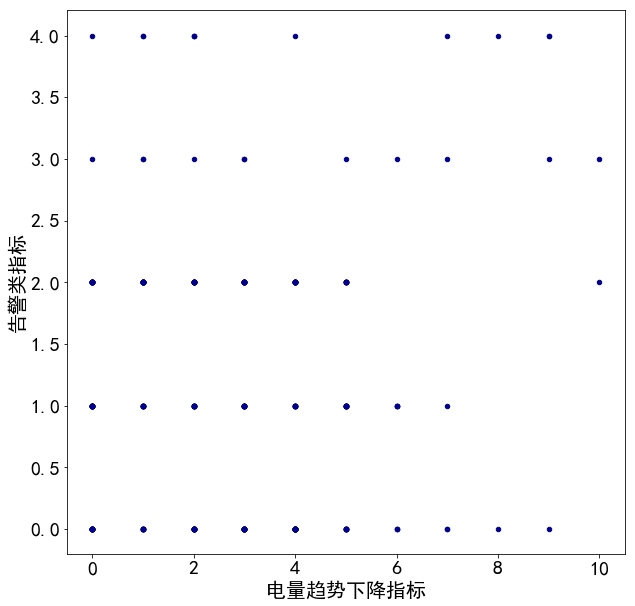
# plot dataset
plot_helpers.discrete_scatter(data.iloc[1:, 0], data.iloc[1:, 2], data.iloc[1:,3])
plt.legend(["Class 0", "Class 1"], loc=4)
plt.xlabel("First feature")
plt.ylabel("Second feature")
print("data[:,:3]].shape:", data.iloc[1:,:3].shape)
data[:,:3]].shape: (290, 3)
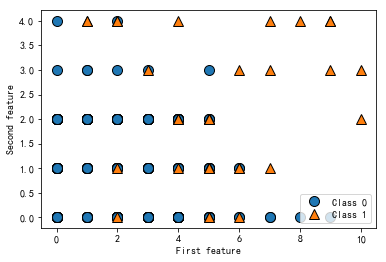
data.plot(kind='hist',alpha=0.5)#与data.plot.hist(alpha=05)造价
<matplotlib.axes._subplots.AxesSubplot at 0x1d52da54c18>
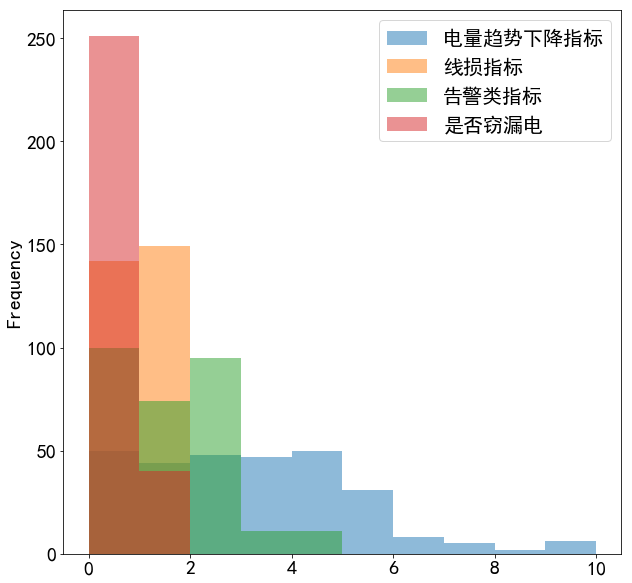
data.hist(figsize=(15,10))#分开绘图
array([[<matplotlib.axes._subplots.AxesSubplot object at 0x000001D52CFB8A90>,
<matplotlib.axes._subplots.AxesSubplot object at 0x000001D52DB4A4E0>],
[<matplotlib.axes._subplots.AxesSubplot object at 0x000001D52E06F978>,
<matplotlib.axes._subplots.AxesSubplot object at 0x000001D52E092EB8>]],
dtype=object)
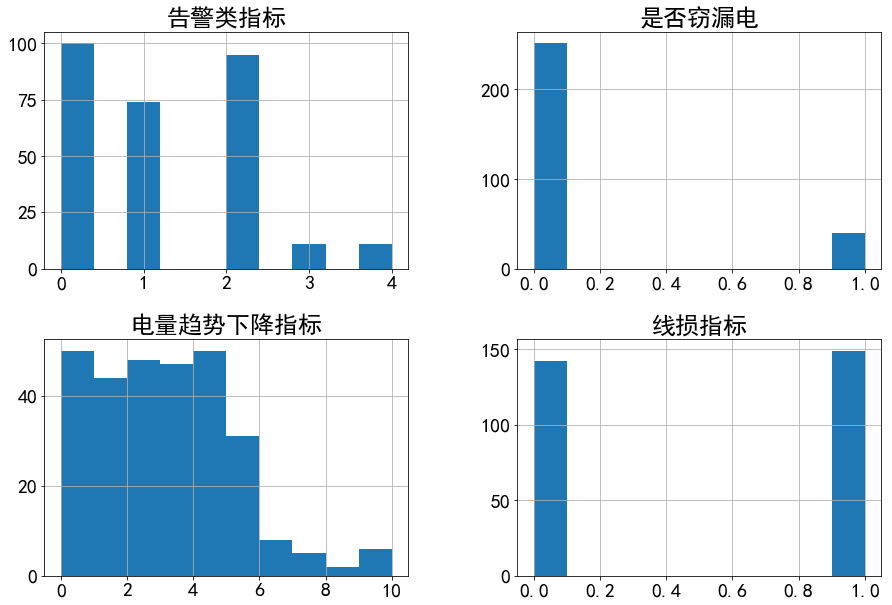
data.plot()
<matplotlib.axes._subplots.AxesSubplot at 0x2148b9d9160>
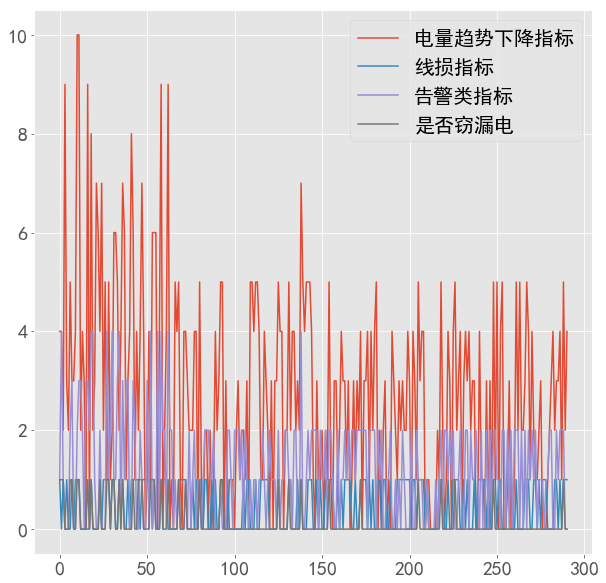
pd.plotting.scatter_matrix(data,figsize=(20,20),alpha=0.2)
array([[<matplotlib.axes._subplots.AxesSubplot object at 0x0000021489E34C50>,
<matplotlib.axes._subplots.AxesSubplot object at 0x0000021489EADDA0>,
<matplotlib.axes._subplots.AxesSubplot object at 0x000002148B5BF198>,
<matplotlib.axes._subplots.AxesSubplot object at 0x000002148B5E66D8>],
[<matplotlib.axes._subplots.AxesSubplot object at 0x000002148B60DC50>,
<matplotlib.axes._subplots.AxesSubplot object at 0x000002148B63F208>,
<matplotlib.axes._subplots.AxesSubplot object at 0x000002148B667780>,
<matplotlib.axes._subplots.AxesSubplot object at 0x000002148B690D30>],
[<matplotlib.axes._subplots.AxesSubplot object at 0x000002148B690D68>,
<matplotlib.axes._subplots.AxesSubplot object at 0x000002148B6E8828>,
<matplotlib.axes._subplots.AxesSubplot object at 0x000002148B712DA0>,
<matplotlib.axes._subplots.AxesSubplot object at 0x000002148B743358>],
[<matplotlib.axes._subplots.AxesSubplot object at 0x000002148B7698D0>,
<matplotlib.axes._subplots.AxesSubplot object at 0x000002148B792E48>,
<matplotlib.axes._subplots.AxesSubplot object at 0x000002148B7C2400>,
<matplotlib.axes._subplots.AxesSubplot object at 0x000002148B7EA978>]],
dtype=object)
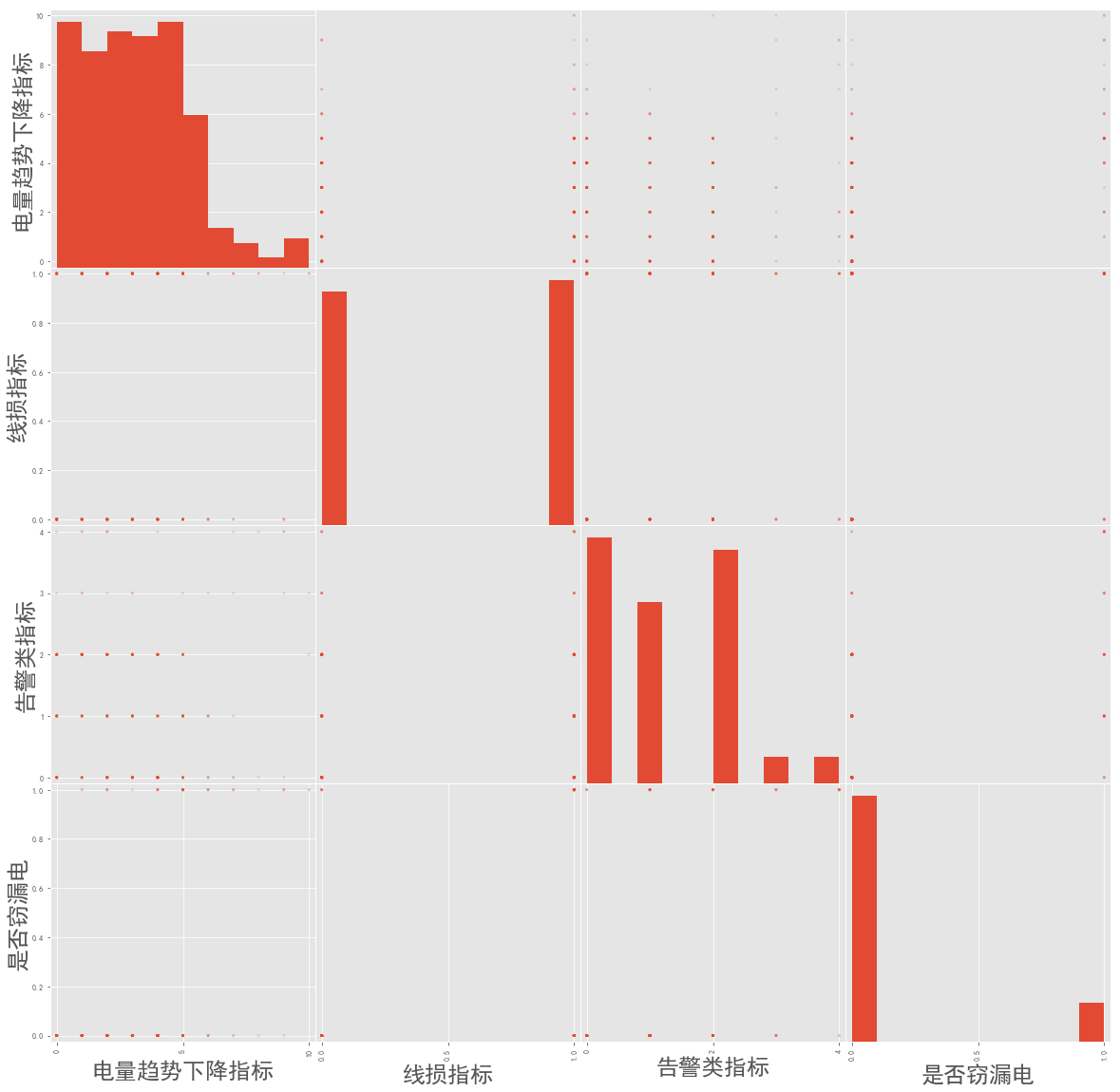
构建KNN模型
#data[[list(data.columns)[0],list(data.columns)[2]]]=data[[list(data.columns)[0],list(data.columns)[2]]].astype(str)
data_dummies=pd.get_dummies(data,columns=[list(data.columns)[0],list(data.columns)[2]])
data_dummies
| 线损指标 | 是否窃漏电 | 电量趋势下降指标_0 | 电量趋势下降指标_1 | 电量趋势下降指标_2 | 电量趋势下降指标_3 | 电量趋势下降指标_4 | 电量趋势下降指标_5 | 电量趋势下降指标_6 | 电量趋势下降指标_7 | 电量趋势下降指标_8 | 电量趋势下降指标_9 | 电量趋势下降指标_10 | 告警类指标_0 | 告警类指标_1 | 告警类指标_2 | 告警类指标_3 | 告警类指标_4 | |
|---|---|---|---|---|---|---|---|---|---|---|---|---|---|---|---|---|---|---|
| 0 | 1 | 1 | 0 | 0 | 0 | 0 | 1 | 0 | 0 | 0 | 0 | 0 | 0 | 0 | 1 | 0 | 0 | 0 |
| 1 | 0 | 1 | 0 | 0 | 0 | 0 | 1 | 0 | 0 | 0 | 0 | 0 | 0 | 0 | 0 | 0 | 0 | 1 |
| 2 | 1 | 1 | 0 | 0 | 1 | 0 | 0 | 0 | 0 | 0 | 0 | 0 | 0 | 0 | 1 | 0 | 0 | 0 |
| 3 | 0 | 0 | 0 | 0 | 0 | 0 | 0 | 0 | 0 | 0 | 0 | 1 | 0 | 1 | 0 | 0 | 0 | 0 |
| 4 | 1 | 0 | 0 | 0 | 0 | 1 | 0 | 0 | 0 | 0 | 0 | 0 | 0 | 1 | 0 | 0 | 0 | 0 |
| ... | ... | ... | ... | ... | ... | ... | ... | ... | ... | ... | ... | ... | ... | ... | ... | ... | ... | ... |
| 286 | 1 | 0 | 0 | 0 | 0 | 0 | 1 | 0 | 0 | 0 | 0 | 0 | 0 | 0 | 0 | 1 | 0 | 0 |
| 287 | 0 | 0 | 0 | 1 | 0 | 0 | 0 | 0 | 0 | 0 | 0 | 0 | 0 | 0 | 0 | 1 | 0 | 0 |
| 288 | 1 | 1 | 0 | 0 | 0 | 0 | 0 | 1 | 0 | 0 | 0 | 0 | 0 | 0 | 0 | 1 | 0 | 0 |
| 289 | 1 | 0 | 0 | 0 | 1 | 0 | 0 | 0 | 0 | 0 | 0 | 0 | 0 | 1 | 0 | 0 | 0 | 0 |
| 290 | 1 | 0 | 0 | 0 | 0 | 0 | 1 | 0 | 0 | 0 | 0 | 0 | 0 | 1 | 0 | 0 | 0 | 0 |
291 rows × 18 columns
data_dummies_cols=list(data_dummies.columns)
first_col=data_dummies_cols.pop(0)
second_col=data_dummies_cols.pop(0)
data_dummies_cols=data_dummies_cols+[first_col,second_col]
data_dummies_cols
['电量趋势下降指标_0',
'电量趋势下降指标_1',
'电量趋势下降指标_2',
'电量趋势下降指标_3',
'电量趋势下降指标_4',
'电量趋势下降指标_5',
'电量趋势下降指标_6',
'电量趋势下降指标_7',
'电量趋势下降指标_8',
'电量趋势下降指标_9',
'电量趋势下降指标_10',
'告警类指标_0',
'告警类指标_1',
'告警类指标_2',
'告警类指标_3',
'告警类指标_4',
'线损指标',
'是否窃漏电']
data_dummies=data_dummies[data_dummies_cols]#.astype(int)
data_dummies
| 电量趋势下降指标_0 | 电量趋势下降指标_1 | 电量趋势下降指标_2 | 电量趋势下降指标_3 | 电量趋势下降指标_4 | 电量趋势下降指标_5 | 电量趋势下降指标_6 | 电量趋势下降指标_7 | 电量趋势下降指标_8 | 电量趋势下降指标_9 | 电量趋势下降指标_10 | 告警类指标_0 | 告警类指标_1 | 告警类指标_2 | 告警类指标_3 | 告警类指标_4 | 线损指标 | 是否窃漏电 | |
|---|---|---|---|---|---|---|---|---|---|---|---|---|---|---|---|---|---|---|
| 0 | 0 | 0 | 0 | 0 | 1 | 0 | 0 | 0 | 0 | 0 | 0 | 0 | 1 | 0 | 0 | 0 | 1 | 1 |
| 1 | 0 | 0 | 0 | 0 | 1 | 0 | 0 | 0 | 0 | 0 | 0 | 0 | 0 | 0 | 0 | 1 | 0 | 1 |
| 2 | 0 | 0 | 1 | 0 | 0 | 0 | 0 | 0 | 0 | 0 | 0 | 0 | 1 | 0 | 0 | 0 | 1 | 1 |
| 3 | 0 | 0 | 0 | 0 | 0 | 0 | 0 | 0 | 0 | 1 | 0 | 1 | 0 | 0 | 0 | 0 | 0 | 0 |
| 4 | 0 | 0 | 0 | 1 | 0 | 0 | 0 | 0 | 0 | 0 | 0 | 1 | 0 | 0 | 0 | 0 | 1 | 0 |
| ... | ... | ... | ... | ... | ... | ... | ... | ... | ... | ... | ... | ... | ... | ... | ... | ... | ... | ... |
| 286 | 0 | 0 | 0 | 0 | 1 | 0 | 0 | 0 | 0 | 0 | 0 | 0 | 0 | 1 | 0 | 0 | 1 | 0 |
| 287 | 0 | 1 | 0 | 0 | 0 | 0 | 0 | 0 | 0 | 0 | 0 | 0 | 0 | 1 | 0 | 0 | 0 | 0 |
| 288 | 0 | 0 | 0 | 0 | 0 | 1 | 0 | 0 | 0 | 0 | 0 | 0 | 0 | 1 | 0 | 0 | 1 | 1 |
| 289 | 0 | 0 | 1 | 0 | 0 | 0 | 0 | 0 | 0 | 0 | 0 | 1 | 0 | 0 | 0 | 0 | 1 | 0 |
| 290 | 0 | 0 | 0 | 0 | 1 | 0 | 0 | 0 | 0 | 0 | 0 | 1 | 0 | 0 | 0 | 0 | 1 | 0 |
291 rows × 18 columns
data_dummies = data_dummies.values #将表格转换为矩阵
data_dummies
array([[0, 0, 0, ..., 0, 1, 1],
[0, 0, 0, ..., 1, 0, 1],
[0, 0, 1, ..., 0, 1, 1],
...,
[0, 0, 0, ..., 0, 1, 1],
[0, 0, 1, ..., 0, 1, 0],
[0, 0, 0, ..., 0, 1, 0]], dtype=int64)
data_dummies[:,-1]
array([0, 1, 0, 0, 0, 0, 0, 0, 0, 0, 0, 0, 0, 0, 0, 0, 0, 0, 1, 1, 0, 0,
0, 0, 0, 0, 0, 1, 0, 0, 1, 0, 0, 0, 1, 0, 0, 0, 0, 0, 0, 0, 0, 0,
0, 0, 0, 0, 0, 0, 0, 0, 1, 0, 0, 0, 1, 0, 1, 0, 0, 0, 1, 0, 0, 0,
0, 0, 0, 0, 0, 0, 0, 0, 0, 0, 0, 0, 0, 0, 0, 0, 0, 0, 0, 0, 0, 0,
0, 0, 0, 0, 0, 0, 0, 0, 0, 0, 0, 0, 0, 0, 0, 0, 0, 0, 0, 0, 0, 0,
0, 0, 0, 0, 0, 0, 0, 0, 0, 0, 0, 0, 0, 0, 0, 0, 0, 0, 0, 0, 0, 0,
0, 0, 0, 0, 0, 0, 1, 0, 0, 0, 0, 0, 0, 0, 0, 0, 0, 0, 0, 0, 0, 0,
0, 0, 0, 0, 0, 0, 0, 0, 0, 0, 0, 0, 0, 0, 0, 0, 0, 0, 0, 0, 0, 0,
0, 0, 0, 0, 0, 0, 0, 0, 0, 0, 0, 0, 0, 0, 0, 0, 0, 0, 0, 0, 0, 0,
0, 0, 0, 0, 0, 0, 0, 0, 0, 0, 0, 0, 0, 0, 0, 0, 0, 0, 0, 0, 0, 0,
0, 0, 0, 0, 0, 0, 0, 0, 0, 0, 0, 0, 0, 0, 0, 0, 0, 0, 0, 0, 0, 0,
0, 0, 0, 0, 0, 0, 0, 0, 0, 0, 0, 0, 0, 0, 0, 0, 0, 0, 0, 0, 0, 0,
0, 0, 0, 0, 0, 0, 0, 0, 0, 0, 0, 0, 0, 0, 0, 0, 0, 0, 0, 0, 0, 0,
0, 0, 0, 0, 0], dtype=int64)
data_dummies.shape[1]
18
from sklearn.model_selection import train_test_split
#train_test_split Parameters
#test_size : float, int or None, optional (default=0.25)
#shuffle : boolean, optional (default=True)
#X_train,X_test,y_train,y_test=train_test_split(data_dummies[:,:data_dummies.shape[1]-1],data_dummies[:,-1],random_state=0)
X_train,X_test,y_train,y_test=train_test_split(data_dummies[:,:-1],data_dummies[:,-1],random_state=60)
X_train
array([[1, 0, 0, ..., 0, 0, 0],
[1, 0, 0, ..., 0, 0, 0],
[0, 0, 0, ..., 0, 0, 0],
...,
[0, 1, 0, ..., 0, 0, 0],
[0, 1, 0, ..., 0, 0, 0],
[0, 0, 0, ..., 0, 1, 0]], dtype=int64)
y_train
array([0, 0, 0, 0, 0, 0, 0, 0, 0, 0, 0, 0, 0, 1, 0, 1, 0, 0, 0, 0, 0, 0,
0, 0, 0, 0, 0, 0, 0, 0, 0, 0, 0, 0, 0, 1, 0, 0, 0, 0, 1, 0, 0, 0,
0, 0, 0, 0, 0, 0, 1, 0, 0, 0, 0, 0, 0, 0, 0, 0, 0, 0, 0, 0, 0, 1,
0, 1, 0, 0, 0, 0, 0, 0, 0, 1, 0, 1, 0, 0, 0, 0, 1, 0, 1, 0, 0, 0,
0, 0, 0, 0, 0, 1, 0, 0, 0, 0, 0, 0, 0, 1, 0, 0, 0, 0, 0, 0, 0, 1,
0, 0, 1, 0, 0, 1, 0, 0, 0, 0, 0, 0, 0, 0, 1, 0, 1, 0, 0, 0, 0, 0,
0, 0, 1, 0, 0, 0, 1, 1, 0, 0, 0, 0, 0, 0, 0, 0, 0, 0, 0, 0, 1, 0,
0, 0, 0, 0, 0, 1, 0, 0, 0, 1, 0, 0, 0, 0, 0, 0, 0, 1, 0, 0, 0, 1,
1, 0, 0, 0, 0, 0, 0, 0, 1, 0, 0, 0, 0, 0, 0, 0, 0, 0, 0, 0, 0, 1,
0, 0, 0, 0, 0, 0, 0, 0, 0, 0, 0, 0, 0, 0, 0, 0, 0, 0, 1, 1],
dtype=int64)
X_test
array([[0, 0, 0, ..., 1, 0, 0],
[0, 0, 1, ..., 0, 0, 0],
[0, 0, 0, ..., 0, 0, 0],
...,
[0, 0, 0, ..., 0, 1, 0],
[1, 0, 0, ..., 0, 1, 0],
[1, 0, 0, ..., 1, 0, 0]], dtype=int64)
print("X_train shape:", X_train.shape)
print("y_train shape:", y_train.shape)
print("y_test shape:", y_test.shape)
X_train shape: (218, 17)
y_train shape: (218,)
y_test shape: (73,)
Logistic回归从根本上解决因变量要不是连续变量怎么办的问题。自变量既可以是连续的,也可以是分类的。然后通过logistic回归分析,可以得到自变量的权重,从而可以大致了解到底哪些因素是胃癌的危险因素。同时根据该权值可以根据危险因素预测一个人患癌症的可能性。 Logistic回归模型的适用条件 1 因变量为二分类的分类变量或某事件的发生率,并且是数值型变量。但是需要注意,重复计数现象指标不适用于Logistic回归。 2 残差和因变量都要服从二项分布。二项分布对应的是分类变量,所以不是正态分布,进而不是用最小二乘法,而是最大似然法来解决方程估计和检验问题。 3 自变量和Logistic概率是线性关系 4 各观测对象间相互独立。
from sklearn.linear_model import LogisticRegression
import numpy as np y = [0,0,0,0,0,0,0,0,1,1,1,1,1,1,2,2] #标签值,一共16个样本 a = np.bincount(y) # array([8, 6, 2], dtype=int64) 计算每个类别的样本数量 aa = 1/a #倒数 array([0.125 , 0.16666667, 0.5 ]) print(aa)
from sklearn.utils.class_weight import compute_class_weight class_weight = ‘balanced’ classes = np.array([0, 1, 2]) #标签类别 weight = compute_class_weight(class_weight, classes, y) print(weight) # [0.66666667 0.88888889 2.66666667]
print(0.666666678) #5.33333336 print(0.888888896) #5.33333334 print(2.66666667*2) #5.33333334 #这三个值非常接近 ‘balanced’计算出来的结果很均衡,使得惩罚项和样本量对应
#由于原始数据不均衡,引入class_weight='balanced'
lg=LogisticRegression(C=1,solver='lbfgs',class_weight='balanced')
lg.fit(X_train,y_train)
LogisticRegression(C=1, class_weight='balanced')
#模型学到的自变量系数
lg.coef_
array([[-1.8982079 , -1.50770935, -0.30930785, -1.54120769, 0.01474898,
1.56566034, 1.02127487, 0.8846096 , -0.03445342, 0.95543708,
0.84902324, -1.79004659, -0.83005007, -0.50817373, 1.13049358,
1.99764472, 1.79664114]])
评估模型
y_pred=lg.predict(X_test)
y_pred
array([0, 0, 0, 0, 0, 1, 0, 0, 1, 0, 1, 0, 0, 0, 1, 0, 0, 1, 0, 0, 1, 1,
0, 0, 0, 0, 0, 0, 0, 0, 0, 0, 1, 0, 0, 0, 0, 1, 0, 1, 0, 0, 1, 0,
0, 1, 0, 0, 0, 1, 0, 0, 0, 1, 0, 0, 0, 0, 0, 1, 0, 1, 0, 0, 0, 0,
0, 1, 0, 1, 0, 0, 1], dtype=int64)
#Accuracy=(TP+TN)/(TP+TN+FP+FN),正确识别率=(60+8)/(60+8+3+2)
lg.score(X_test,y_test)
0.863013698630137
from sklearn.metrics import confusion_matrix
confusion=confusion_matrix(y_test,y_pred)
y_test.sum()
11
y_test.size
73
confusion
array([[53, 9],
[ 1, 10]], dtype=int64)
from sklearn.metrics import plot_confusion_matrix
plot_confusion_matrix(lg,X_test,y_test)
<sklearn.metrics._plot.confusion_matrix.ConfusionMatrixDisplay at 0x2457c5a5748>
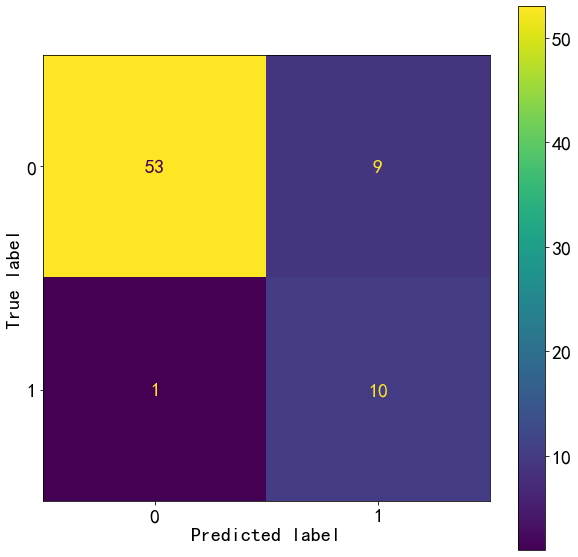
from sklearn.metrics import f1_score
test_score=f1_score(y_test,y_pred)
test_score
0.6666666666666666
from sklearn.metrics import classification_report
test_report=classification_report(y_test,y_pred,target_names=["0","1"])
#precision=TP/(TP+FP),如{1}:8/(8+2),{0}:60/(60+3)。FP假正例,为预测正确实际错误
#recall=TP/(TP+FN),{1}:8/(8+3),{0}:60/(60+2)。FN假反例,预测错误实际正确
#这个项目1的recall非常重要,数据不平衡,因此引入class_weight='balanced'
print(test_report)
precision recall f1-score support
0 0.98 0.85 0.91 62
1 0.53 0.91 0.67 11
accuracy 0.86 73
macro avg 0.75 0.88 0.79 73
weighted avg 0.91 0.86 0.88 73
y_pred_lower_threshold=lg.decision_function(X_test)>-0.5
test_report_lower_theshold=classification_report(y_test,y_pred_lower_threshold)
print(test_report_lower_theshold)
---------------------------------------------------------------------------
NameError Traceback (most recent call last)
<ipython-input-29-99dfdd4c5dbd> in <module>
----> 1 test_report_lower_theshold=classification_report(y_test,y_pred_lower_threshold)
2 print(test_report_lower_theshold)
NameError: name 'classification_report' is not defined
y_train_pred=lg.predict(X_train)
confusion_train=confusion_matrix(y_train,y_train_pred)
confusion_train
array([[162, 27],
[ 2, 27]], dtype=int64)
plot_confusion_matrix(lg,X_train,y_train)
<sklearn.metrics._plot.confusion_matrix.ConfusionMatrixDisplay at 0x2457cc850c8>

print(classification_report(y_train,y_train_pred,target_names=['0','1']))
precision recall f1-score support
0 0.99 0.86 0.92 189
1 0.50 0.93 0.65 29
accuracy 0.87 218
macro avg 0.74 0.89 0.78 218
weighted avg 0.92 0.87 0.88 218
准确率-召回率曲线
from sklearn.metrics import precision_recall_curve
#predict_proba: 模型预测输入样本属于每种类别的概率,概率和为1,每个位置的概率分别对应classes_中对应位置的类别标签。knn.class_=[0,1]
lg.predict_proba(X_test)[:,1]
array([0.04807361, 0.0129165 , 0.01835642, 0.22136398, 0.23341758,
0.86809927, 0.27874242, 0.08141368, 0.73891599, 0.06023652,
0.50232206, 0.29582958, 0.23341758, 0.19533512, 0.58204273,
0.36619901, 0.18763114, 0.86809927, 0.34827022, 0.01835642,
0.88576147, 0.86809927, 0.29582958, 0.24205981, 0.24205981,
0.0129165 , 0.29582958, 0.18763114, 0.28889944, 0.1013232 ,
0.06513878, 0.06023652, 0.94464191, 0.07312772, 0.34827022,
0.01835642, 0.06312835, 0.65818615, 0.22136398, 0.90079889,
0.08141368, 0.34827022, 0.65818615, 0.06312835, 0.14339758,
0.58204273, 0.0129165 , 0.06312835, 0.24205981, 0.86809927,
0.06513878, 0.03304592, 0.27874242, 0.79647369, 0.29582958,
0.06312835, 0.19516898, 0.28889944, 0.34827022, 0.58257308,
0.34827022, 0.98372519, 0.18796373, 0.08141368, 0.1013232 ,
0.18763114, 0.08141368, 0.71590931, 0.03304592, 0.52188984,
0.06513878, 0.28889944, 0.50232206])
precision,recall,thresholds=precision_recall_curve(y_test,lg.predict_proba(X_test)[:,1])
thresholds
array([0.19516898, 0.19533512, 0.22136398, 0.23341758, 0.24205981,
0.27874242, 0.28889944, 0.29582958, 0.34827022, 0.36619901,
0.50232206, 0.52188984, 0.58204273, 0.58257308, 0.65818615,
0.71590931, 0.73891599, 0.79647369, 0.86809927, 0.88576147,
0.90079889, 0.94464191, 0.98372519])
# find threshold closest to zero
close_zero = np.argmin(np.abs(thresholds))
plt.plot(precision[close_zero], recall[close_zero], 'o', markersize=10,
label="threshold zero", fillstyle="none", c='k', mew=2)
plt.plot(precision, recall, label="precision recall curve")
plt.xlabel("Precision")
plt.ylabel("Recall")
plt.legend(loc="best")
<matplotlib.legend.Legend at 0x2457c51a508>
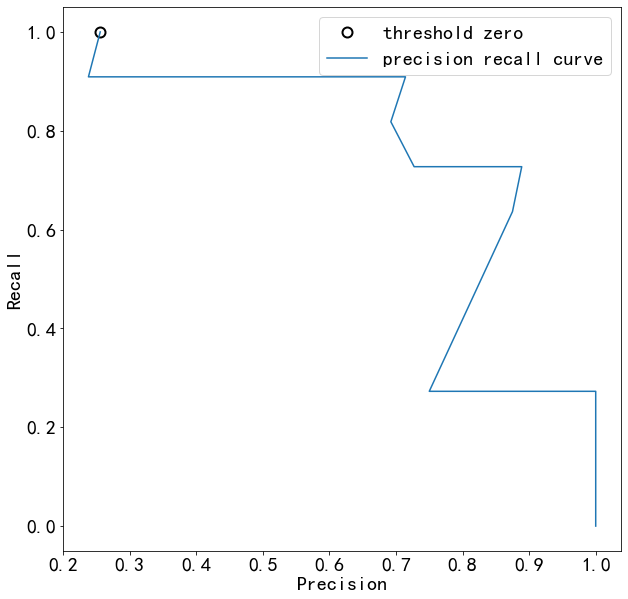
from sklearn.metrics import plot_precision_recall_curve
plot_precision_recall_curve(lg,X_test,y_test)
<sklearn.metrics._plot.precision_recall_curve.PrecisionRecallDisplay at 0x2457c7dc6c8>
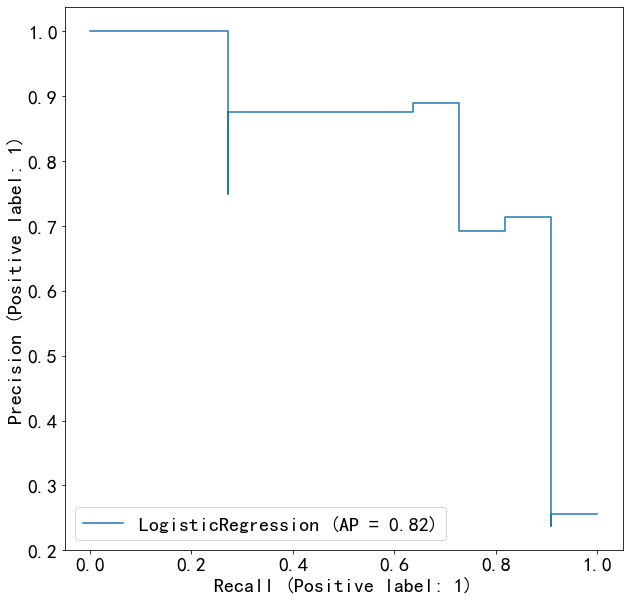
#from sklearn.metrics import plot_confusion_matrix
from sklearn.metrics import plot_confusion_matrix
from sklearn.metrics import average_precision_score
ap_clf=average_precision_score(y_test,lg.predict_proba(X_test)[:,1])
ap_clf
0.8228451135427879
from sklearn.metrics import roc_curve
fpr,tpr,thresholds=roc_curve(y_test,lg.predict_proba(X_test)[:,1])
plt.plot(fpr,tpr,label="ROC Curve")
plt.xlabel('FPR')
plt.ylabel('TPR(Recall)')
#找到最接近于0的阈值
close_zero=np.argmin(np.abs(thresholds))
plt.plot(fpr[close_zero],tpr[close_zero],'o',markersize=10,label='threshold zero',fillstyle='none',c='k',mew=2)
plt.legend(loc=4)
<matplotlib.legend.Legend at 0x2457c2db708>
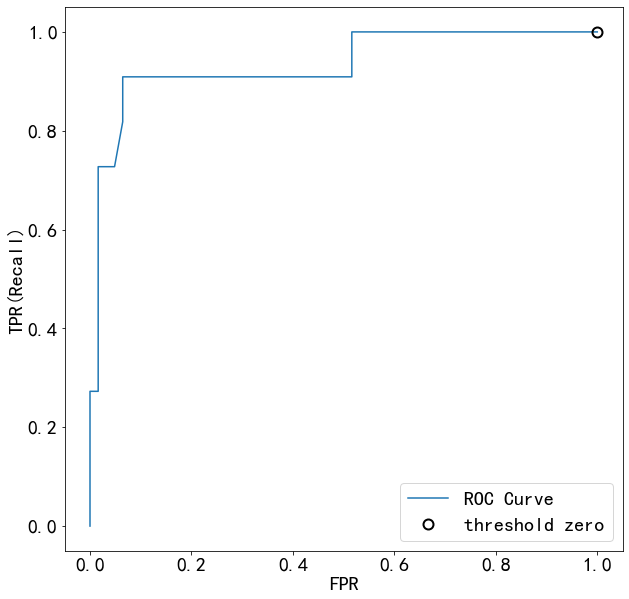
from sklearn.metrics import plot_roc_curve
plot_roc_curve(lg,X_test,y_test)
<sklearn.metrics._plot.roc_curve.RocCurveDisplay at 0x2457ca46688>
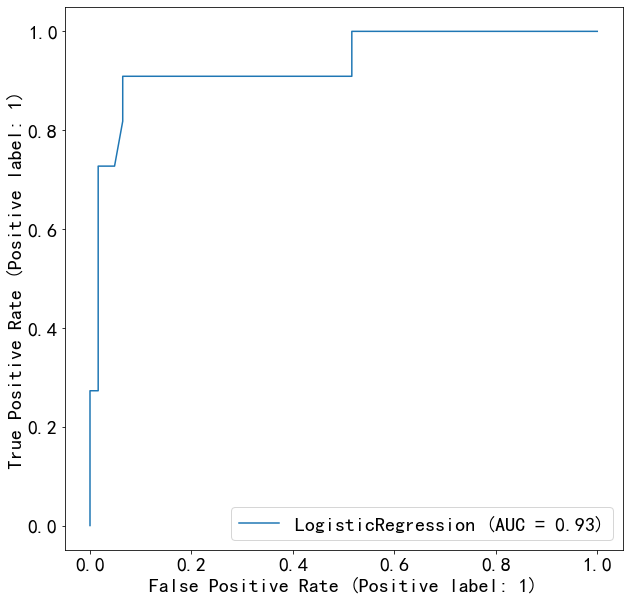
from sklearn.metrics import roc_auc_score
auc=roc_auc_score(y_test,lg.predict_proba(X_test)[:,1])
print('AUC={:.2f}'.format(auc))
fpr,tpr,_=roc_curve(y_test,lg.predict_proba(X_test)[:,1])
plt.plot(fpr,tpr,label='XXX')
plt.xlabel('FPR')
plt.ylabel('TPR')
plt.xlim(-0.01,1)
plt.ylim(0,1.02)
plt.legend(loc='best')
AUC=0.93
<matplotlib.legend.Legend at 0x2457ec5b708>
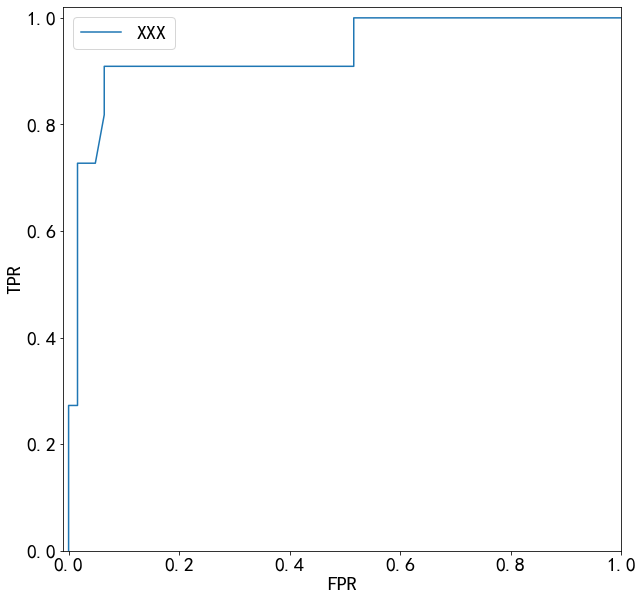
from sklearn.model_selection import GridSearchCV
from sklearn.linear_model import LogisticRegression
param_grid=[{'penalty':['l2'],'class_weight':['balanced',None],'solver':['sag','lbfgs','newton-cg']},
{'penalty':['l1'],'class_weight':['balanced',None],'solver':['saga']},
{'penalty':['l1','l2'],'class_weight':['balanced',None],'solver':['liblinear']}]
grid_search=GridSearchCV(LogisticRegression(max_iter=1000),param_grid,cv=5,scoring='recall')
grid_search.fit(X_train,y_train)
C:\Users\SF\Anaconda3\lib\site-packages\sklearn\linear_model\_sag.py:329: ConvergenceWarning: The max_iter was reached which means the coef_ did not converge
"the coef_ did not converge", ConvergenceWarning)
C:\Users\SF\Anaconda3\lib\site-packages\sklearn\linear_model\_sag.py:329: ConvergenceWarning: The max_iter was reached which means the coef_ did not converge
"the coef_ did not converge", ConvergenceWarning)
C:\Users\SF\Anaconda3\lib\site-packages\sklearn\linear_model\_sag.py:329: ConvergenceWarning: The max_iter was reached which means the coef_ did not converge
"the coef_ did not converge", ConvergenceWarning)
C:\Users\SF\Anaconda3\lib\site-packages\sklearn\linear_model\_sag.py:329: ConvergenceWarning: The max_iter was reached which means the coef_ did not converge
"the coef_ did not converge", ConvergenceWarning)
C:\Users\SF\Anaconda3\lib\site-packages\sklearn\linear_model\_sag.py:329: ConvergenceWarning: The max_iter was reached which means the coef_ did not converge
"the coef_ did not converge", ConvergenceWarning)
GridSearchCV(cv=5, estimator=LogisticRegression(max_iter=10000),
param_grid=[{'class_weight': ['balanced', None], 'penalty': ['l2'],
'solver': ['sag', 'lbfgs', 'newton-cg']},
{'class_weight': ['balanced', None], 'penalty': ['l1'],
'solver': ['saga']},
{'class_weight': ['balanced', None],
'penalty': ['l1', 'l2'], 'solver': ['liblinear']}],
scoring='recall')
grid_search.score(X_test,y_test)
0.9090909090909091
grid_search.best_estimator_
LogisticRegression(class_weight='balanced', max_iter=10000, solver='liblinear')
grid_search.best_params_
{'class_weight': 'balanced', 'penalty': 'l2', 'solver': 'liblinear'}
results=pd.DataFrame(grid_search.cv_results_)
results.head()
| mean_fit_time | std_fit_time | mean_score_time | std_score_time | param_class_weight | param_penalty | param_solver | params | split0_test_score | split1_test_score | split2_test_score | split3_test_score | split4_test_score | mean_test_score | std_test_score | rank_test_score | |
|---|---|---|---|---|---|---|---|---|---|---|---|---|---|---|---|---|
| 0 | 0.006589 | 0.002055 | 0.000791 | 3.956447e-04 | balanced | l2 | sag | {'class_weight': 'balanced', 'penalty': 'l2', ... | 0.833333 | 0.833333 | 0.833333 | 0.8 | 0.666667 | 0.793333 | 0.064636 | 2 |
| 1 | 0.004988 | 0.000630 | 0.000796 | 3.981196e-04 | balanced | l2 | lbfgs | {'class_weight': 'balanced', 'penalty': 'l2', ... | 0.833333 | 0.833333 | 0.833333 | 0.8 | 0.666667 | 0.793333 | 0.064636 | 2 |
| 2 | 0.004792 | 0.000402 | 0.000998 | 1.907349e-07 | balanced | l2 | newton-cg | {'class_weight': 'balanced', 'penalty': 'l2', ... | 0.833333 | 0.833333 | 0.833333 | 0.8 | 0.666667 | 0.793333 | 0.064636 | 2 |
| 3 | 0.001591 | 0.000496 | 0.000598 | 4.885776e-04 | None | l2 | sag | {'class_weight': None, 'penalty': 'l2', 'solve... | 0.166667 | 0.666667 | 0.333333 | 0.0 | 0.333333 | 0.300000 | 0.221108 | 8 |
| 4 | 0.003790 | 0.000399 | 0.000598 | 4.886555e-04 | None | l2 | lbfgs | {'class_weight': None, 'penalty': 'l2', 'solve... | 0.166667 | 0.666667 | 0.333333 | 0.0 | 0.333333 | 0.300000 | 0.221108 | 8 |
m_best=grid_search.best_estimator_
from sklearn.metrics import precision_score
y_pred=m_best.predict(X_test)
precision_score(y_test,y_pred)
0.5263157894736842
from sklearn.metrics import plot_confusion_matrix
plot_confusion_matrix(m_best,X_test,y_test)
<sklearn.metrics._plot.confusion_matrix.ConfusionMatrixDisplay at 0x2040cc2f198>
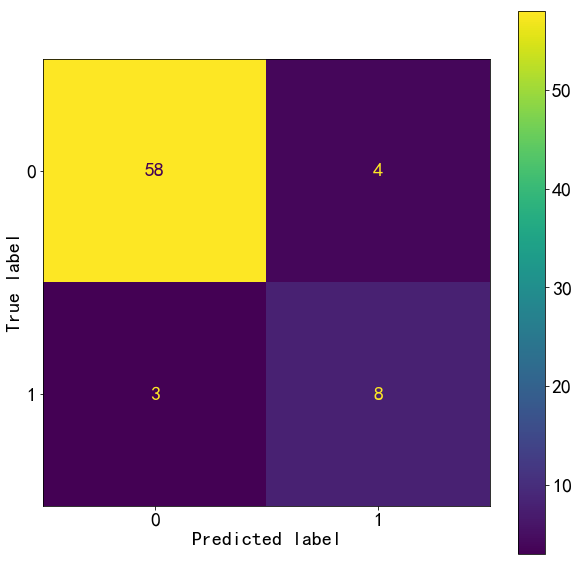
from sklearn.metrics import classification_report
test_report=classification_report(y_test,y_pred,target_names=["0","1"])
print(test_report)
precision recall f1-score support
0 0.98 0.85 0.91 62
1 0.53 0.91 0.67 11
accuracy 0.86 73
macro avg 0.75 0.88 0.79 73
weighted avg 0.91 0.86 0.88 73
决策树:离散型数据1
data = data.values #将表格转换为矩阵
from sklearn.model_selection import train_test_split
#train_test_split Parameters
#test_size : float, int or None, optional (default=0.25)
#shuffle : boolean, optional (default=True)
X_train,X_test,y_train,y_test=train_test_split(data[:,:3],data[:,3],random_state=60)
from sklearn.model_selection import GridSearchCV
from sklearn.tree import DecisionTreeClassifier
param_grid=[{'criterion':['entropy'],'min_impurity_decrease':np.linspace(0,1,50)},
{'criterion':['gini'],'min_impurity_decrease':np.linspace(0,0.5,50)},
{'max_depth':range(2,11)},
{'min_samples_split':range(2,30,2)}]
grid_search=GridSearchCV(DecisionTreeClassifier(),param_grid,cv=5,scoring='recall')
from sklearn.model_selection import GridSearchCV
from sklearn.tree import DecisionTreeClassifier
param_grid={'criterion':['gini','entropy'],'splitter':['best','random'],'max_depth':range(2,11),
'min_samples_split':range(2,30,2),'min_samples_leaf':range(2,11)}
grid_search=GridSearchCV(DecisionTreeClassifier(random_state=0),param_grid,cv=5,scoring='recall')
grid_search.fit(X_train,y_train)
GridSearchCV(cv=5, estimator=DecisionTreeClassifier(random_state=0),
param_grid={'criterion': ['gini', 'entropy'],
'max_depth': range(2, 11),
'min_samples_leaf': range(2, 11),
'min_samples_split': range(2, 30, 2),
'splitter': ['best', 'random']},
scoring='recall')
grid_search.best_params_()
{'criterion': 'gini',
'max_depth': 6,
'min_samples_leaf': 2,
'min_samples_split': 18,
'splitter': 'random'}
grid_search.best_score_
0.7933333333333334
grid_search.best_estimator_
DecisionTreeClassifier(max_depth=6, min_samples_leaf=2, min_samples_split=18,
random_state=0, splitter='random')
m_best=grid_search.best_estimator_
from sklearn.metrics import precision_score
y_pred=m_best.predict(X_test)
precision_score(y_test,y_pred)
0.6666666666666666
m_best.score(X_train,y_train)
0.926605504587156
from sklearn.metrics import plot_confusion_matrix
plot_confusion_matrix(m_best,X_test,y_test)
<sklearn.metrics._plot.confusion_matrix.ConfusionMatrixDisplay at 0x2040d6b3e80>
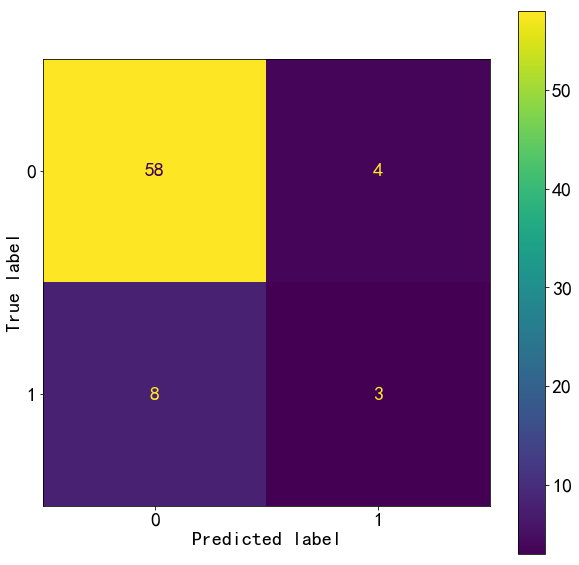
from sklearn.metrics import classification_report
test_report=classification_report(y_test,y_pred,target_names=["0","1"])
print(test_report)
precision recall f1-score support
0 0.95 0.94 0.94 62
1 0.67 0.73 0.70 11
accuracy 0.90 73
macro avg 0.81 0.83 0.82 73
weighted avg 0.91 0.90 0.91 73
imblearn,决策树
注意:对训练集和测试集都要重新采样。 在重采样以减轻数据不平衡问题时,存在一个常见的陷阱,该陷阱为在将整个数据集拆分为训练集和测试集之前对整个数据集进行重采样。
这样的处理导致两个问题:
通过对整个数据集进行重新采样,训练集和测试集都可能得到平衡,而模型应该在自然不平衡的数据集上进行测试,以评估模型的潜在偏差。
重新采样过程可能会使用数据集中样本的信息来生成或选择一些样本。因此,我们可能会使用样本信息,这些信息以后将用作测试样本,这是典型的数据泄漏问题。 from imblearn.under_sampling import RandomUnderSampler 重采样的正确方法是使用Pipeline对训练集和测试集分别重新采样,这样可以避免任何数据泄漏。
data = data.values #将表格转换为矩阵
from sklearn.model_selection import train_test_split
#train_test_split Parameters
#test_size : float, int or None, optional (default=0.25)
#shuffle : boolean, optional (default=True)
X_train,X_test,y_train,y_test=train_test_split(data[:,:3],data[:,3],random_state=60)
from imblearn.pipeline import Pipeline
from imblearn.under_sampling import RandomUnderSampler
from sklearn.tree import DecisionTreeClassifier
pipe=Pipeline([('imblearn',RandomUnderSampler(random_state=0)),('clf',DecisionTreeClassifier(random_state=0))])
from sklearn.model_selection import GridSearchCV
param_grid={'clf__criterion':['gini','entropy'],'clf__splitter':['best','random'],'clf__max_depth':range(2,11),
'clf__min_samples_split':range(2,30,2),'clf__min_samples_leaf':range(2,11)}
grid_search=GridSearchCV(pipe,param_grid,cv=5,scoring='recall')
grid_search.fit(X_train,y_train)
GridSearchCV(cv=5,
estimator=Pipeline(steps=[('imblearn',
RandomUnderSampler(random_state=0)),
('clf',
DecisionTreeClassifier(random_state=0))]),
param_grid={'clf__criterion': ['gini', 'entropy'],
'clf__max_depth': range(2, 11),
'clf__min_samples_leaf': range(2, 11),
'clf__min_samples_split': range(2, 30, 2),
'clf__splitter': ['best', 'random']},
scoring='recall')
grid_search.best_params_()
---------------------------------------------------------------------------
TypeError Traceback (most recent call last)
<ipython-input-16-522bf72df7ed> in <module>
----> 1 grid_search.best_params_()
TypeError: 'dict' object is not callable
grid_search.best_score_
0.8666666666666668
grid_search.best_estimator_
Pipeline(steps=[('imblearn', RandomUnderSampler(random_state=0)),
('clf',
DecisionTreeClassifier(max_depth=2, min_samples_leaf=2,
random_state=0, splitter='random'))])
m_best=grid_search.best_estimator_
from sklearn.metrics import balanced_accuracy_score
y_test_pred=m_best.predict(X_test)
balanced_accuracy_score(y_test,y_pred)
0.7419354838709677
m_best.score(X_train,y_train)
0.5825688073394495
m_best.score(X_train,y_train)
0.5825688073394495
from sklearn.metrics import plot_confusion_matrix
plot_confusion_matrix(m_best,X_test,y_test)
<sklearn.metrics._plot.confusion_matrix.ConfusionMatrixDisplay at 0x1aef8921358>
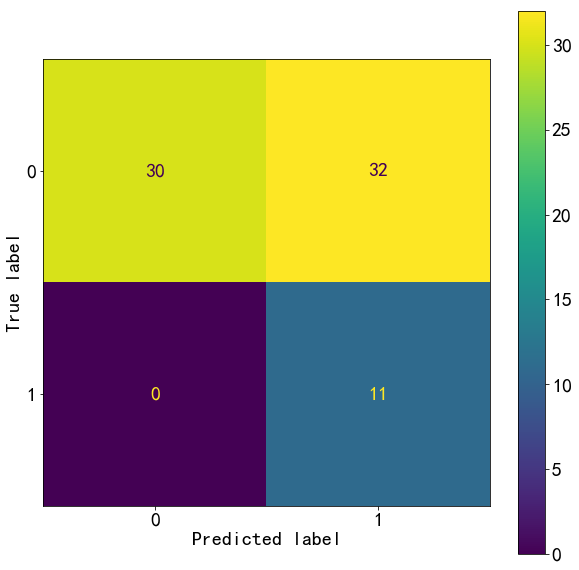
from sklearn.metrics import classification_report
test_report=classification_report(y_test,y_test_pred,target_names=["0","1"])
print(test_report)
precision recall f1-score support
0 1.00 0.48 0.65 62
1 0.26 1.00 0.41 11
accuracy 0.56 73
macro avg 0.63 0.74 0.53 73
weighted avg 0.89 0.56 0.62 73
plot_confusion_matrix(m_best,X_train,y_train)
<sklearn.metrics._plot.confusion_matrix.ConfusionMatrixDisplay at 0x1aef86ba2b0>
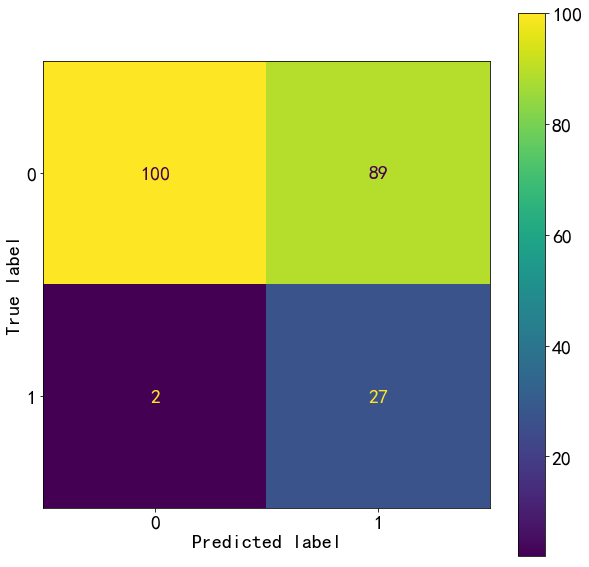
y_train_pred=m_best.predict(X_train)
train_report=classification_report(y_train,y_train_pred,target_names=["0","1"])
print(train_report)
precision recall f1-score support
0 0.98 0.53 0.69 189
1 0.23 0.93 0.37 29
accuracy 0.58 218
macro avg 0.61 0.73 0.53 218
weighted avg 0.88 0.58 0.65 218
文档信息
- 本文作者:danielsywang
- 本文链接:https://danielsywang.github.io/2019/05/23/ml-prictice-classifier/
- 版权声明:自由转载-非商用-非衍生-保持署名(创意共享3.0许可证)